20 World’s Most Beautiful Cathedrals You Should Visit At Least Once
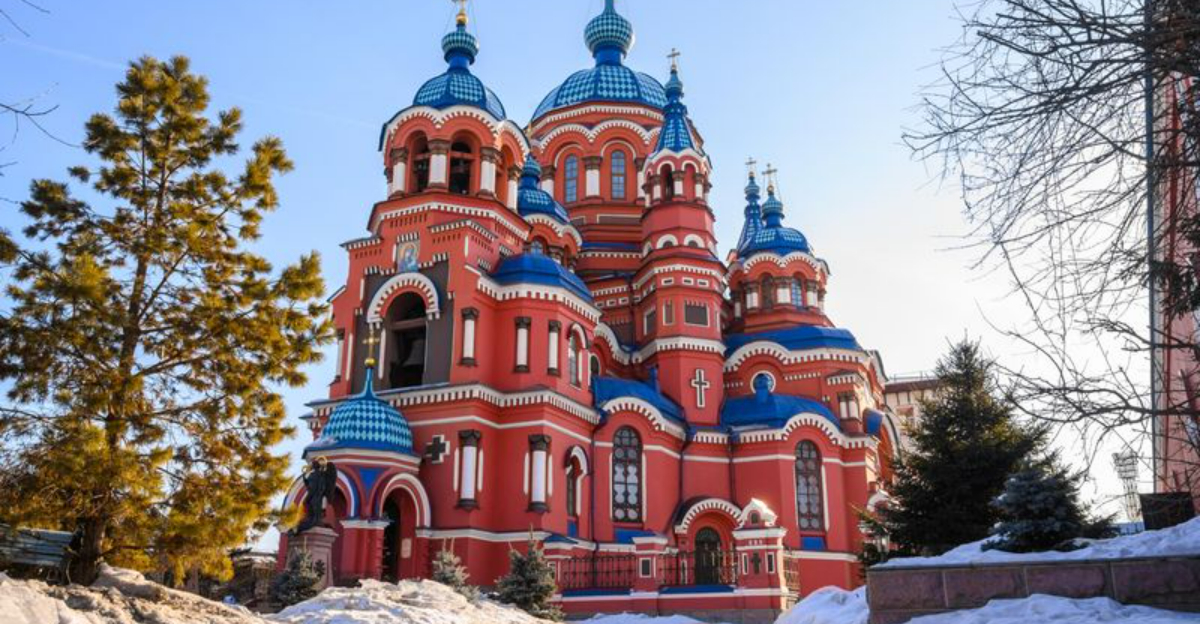
Cathedrals stand as magnificent testaments to human creativity, faith, and architectural genius throughout history. These awe-inspiring structures combine breathtaking artistry with profound spiritual significance, creating spaces that touch visitors regardless of their religious beliefs.
From soaring spires to intricate stained glass, each cathedral tells a unique story of the era and culture that created it.
1. Sagrada Familia – Barcelona, Spain
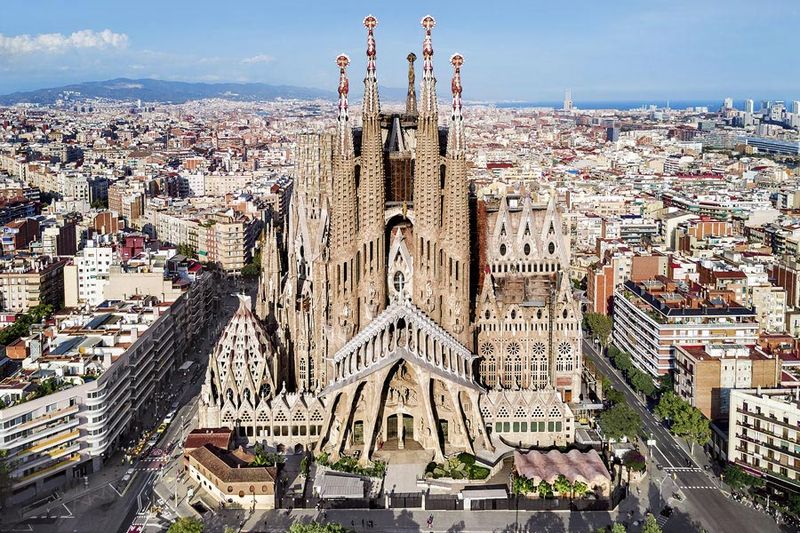
Antoni Gaudí’s unfinished masterpiece continues to mesmerize millions of visitors each year. The cathedral’s organic forms and mathematical precision create a space that feels both otherworldly and deeply spiritual.
Sunlight filters through colorful stained glass, painting rainbow patterns across the white stone interior. Construction began in 1882 and remains ongoing, with completion expected around 2026.
The fusion of Gothic and Art Nouveau influences results in a structure unlike any other cathedral on earth. Climbing one of the towers offers spectacular views of Barcelona, though tickets should be purchased well in advance to avoid disappointment.
2. Notre-Dame Cathedral – Paris, France
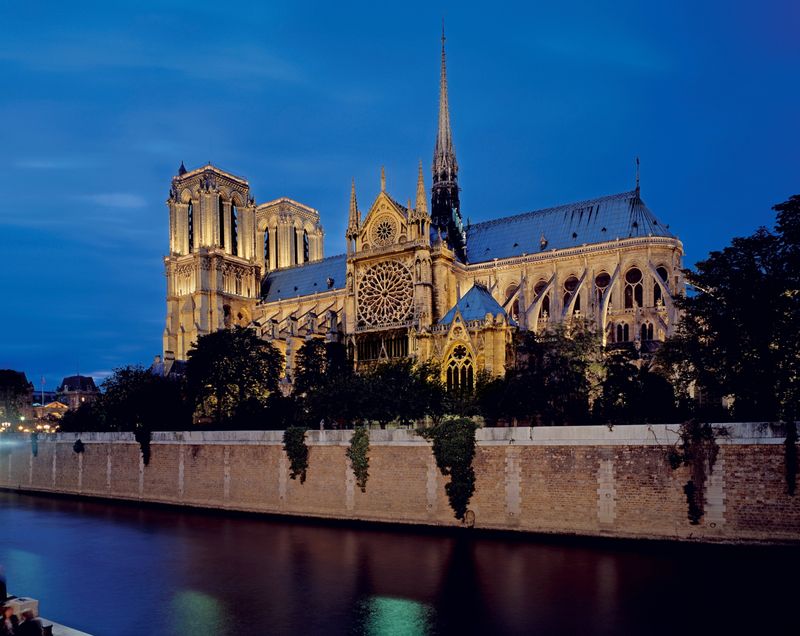
Despite the devastating 2019 fire, Notre-Dame remains an essential pilgrimage for architecture lovers. This Gothic jewel has witnessed over 850 years of Parisian history from its perch on the Île de la Cité.
Gargoyles and chimeras peer down from the facade, while flying buttresses support the soaring walls. The meticulous restoration effort underway promises to return this beloved landmark to its former glory.
Many visitors miss the archaeological crypt beneath the cathedral, which reveals remnants of Roman and medieval Paris. When fully restored, the cathedral will once again showcase its magnificent rose windows and restored spire.
3. St. Peter’s Basilica – Vatican City
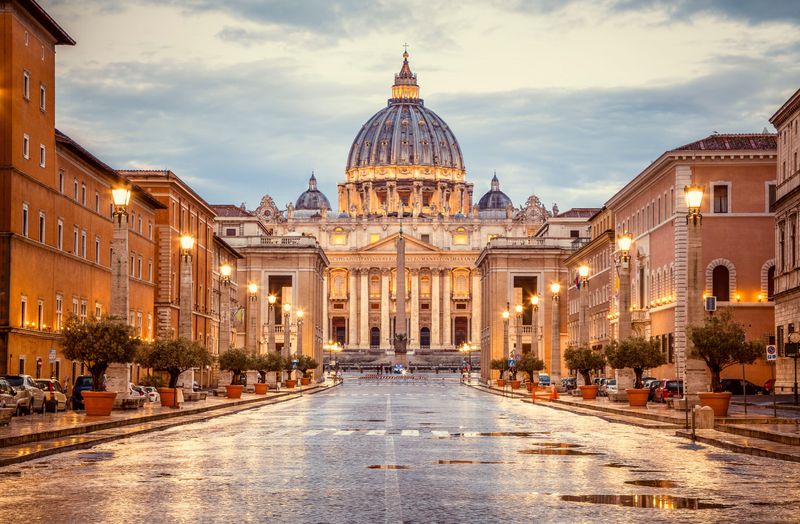
Heart of the Catholic world, St. Peter’s overwhelms visitors with its sheer scale and opulence. The massive dome, designed by Michelangelo, hovers impossibly high above the marble floors.
Bernini’s bronze baldachin marks the supposed burial site of St. Peter himself. The basilica houses numerous artistic treasures, including Michelangelo’s heart-wrenching Pietà sculpture, protected behind bulletproof glass since a 1972 attack.
For spectacular views, climb the 551 steps to the top of the dome (or take the elevator part way). The climb gets increasingly narrow and sloped as you ascend, but the panoramic vista of Rome and the Vatican Gardens rewards your effort.
4. Cologne Cathedral – Cologne, Germany
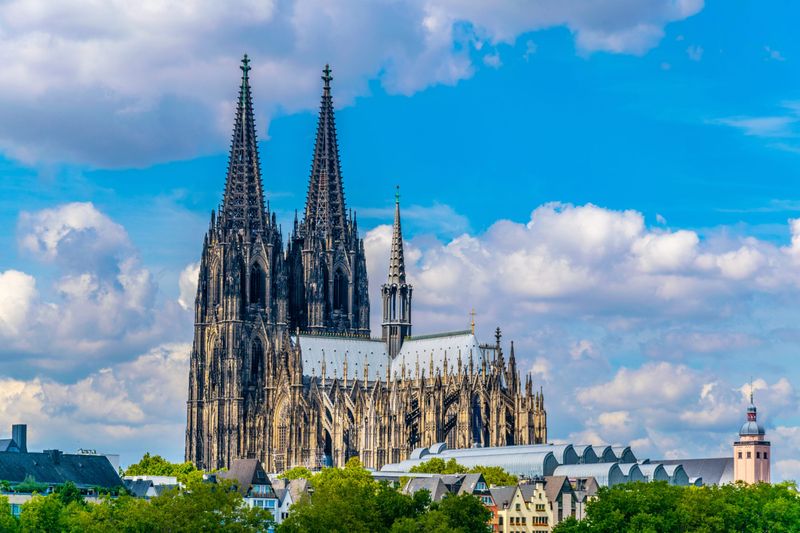
Reaching impossibly toward heaven, Cologne Cathedral’s twin spires dominated the skyline for centuries. This Gothic masterpiece miraculously survived World War II bombing that destroyed much of the surrounding city.
Construction began in 1248 but wasn’t completed until 1880, making it one of history’s longest building projects. The cathedral houses the gilded Shrine of the Three Kings, believed to contain relics of the Biblical Magi.
Climbing the south tower rewards visitors with breathtaking Rhine views after conquering 533 spiral steps. The cathedral’s stained glass spans seven centuries, from medieval masterpieces to modern works created after wartime losses.
5. St. Basil’s Cathedral – Moscow, Russia
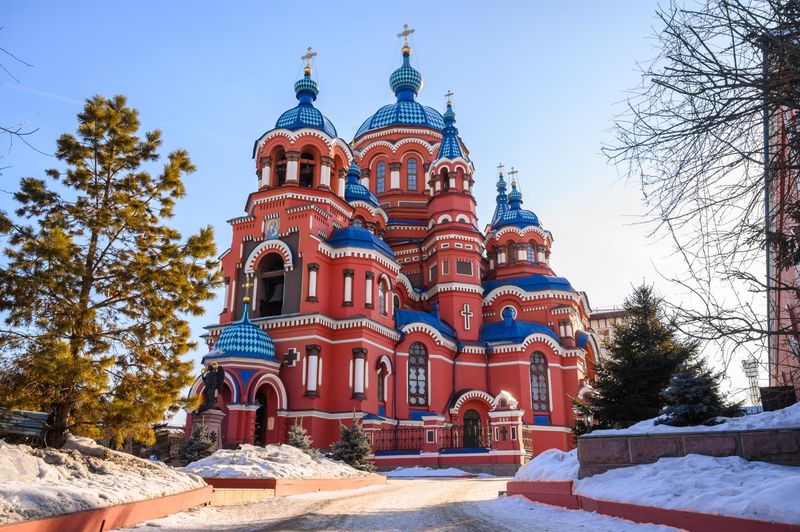
With its candy-colored onion domes, St. Basil’s seems more fairytale castle than place of worship. Legend claims Ivan the Terrible blinded the architects to prevent them from creating anything more beautiful.
Built between 1555 and 1561 to celebrate the capture of Kazan, this architectural fever dream consists of nine chapels arranged around a central tower. Each dome has a unique pattern and color scheme, creating the instantly recognizable silhouette in Red Square.
The labyrinthine interior feels surprisingly intimate compared to the flamboyant exterior. Narrow corridors connect the chapels, each with distinct decoration and icons. Winter visitors might catch the haunting sounds of the cathedral’s choir performing in the acoustically perfect space.
6. Hagia Sophia – Istanbul, Turkey
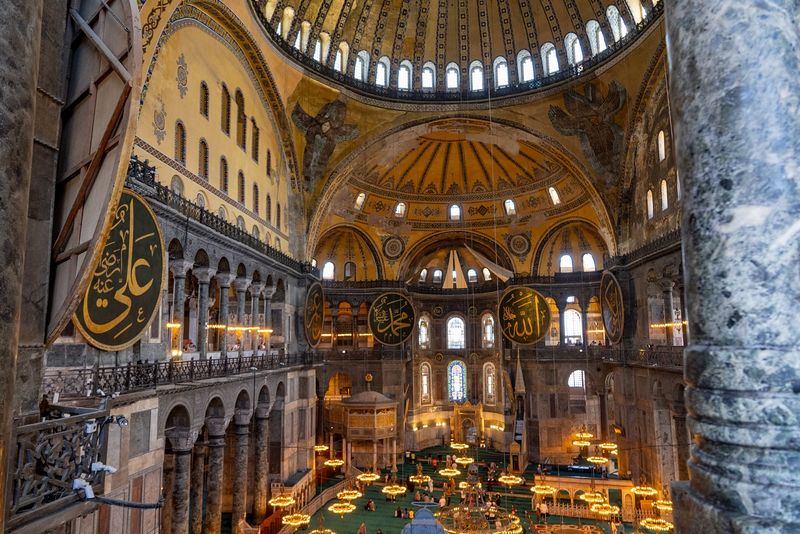
Few buildings have witnessed as much history as Hagia Sophia, which has served as Byzantine cathedral, Ottoman mosque, secular museum, and mosque again. Its massive dome, an engineering marvel of the 6th century, appears to float above the interior space.
Islamic calligraphy and Christian mosaics coexist in this architectural palimpsest. The building’s history reflects Istanbul itself – a crossroads where East meets West and multiple faiths have left their mark.
Visitors should look for the Viking graffiti scratched by Varangian Guards nearly a thousand years ago. The play of light through the dome’s windows creates an otherworldly atmosphere that has moved visitors for fifteen centuries.
7. St. Paul’s Cathedral – London, England
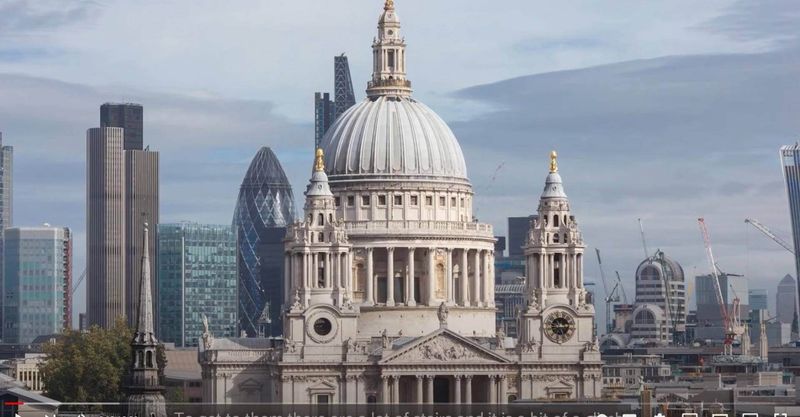
Christopher Wren’s masterpiece has defined London’s skyline since rising from the ashes of the Great Fire. The dome’s survival during the Blitz bombings became a symbol of British resilience.
Whisper secrets in the Whispering Gallery, where sound travels mysteriously across the dome. The cathedral has hosted momentous events from Winston Churchill’s funeral to Prince Charles and Diana’s wedding.
Most visitors miss the geometric staircase that appeared in Harry Potter films. For the best experience, attend Evensong service when the space fills with the ethereal voices of the cathedral choir. The view from the Golden Gallery rewards those who climb all 528 steps with a panoramic vista of London.
8. Milan Cathedral – Milan, Italy
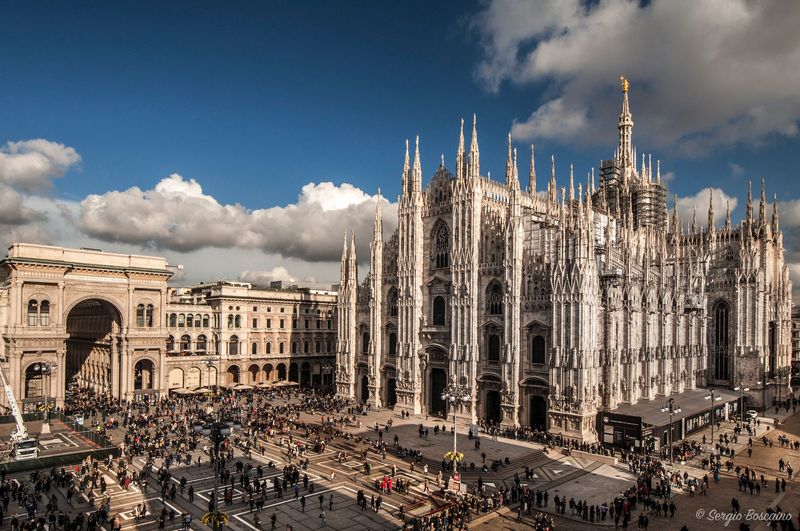
Forest of spires reaching skyward, Milan’s Duomo took nearly six centuries to complete. More than 3,400 statues adorn this Gothic masterpiece, with new figures still being carved to replace weathered predecessors.
The rooftop experience sets Milan Cathedral apart from other European churches. Visitors can walk among the forest of pinnacles and examine the intricate marble carvings up close while enjoying panoramic city views.
Look for the small red light bulb marking the spot where one of the nails from Christ’s crucifixion is supposedly kept. The cathedral’s vast interior seems designed to make humans feel appropriately humble, with massive columns stretching toward heaven.
9. Westminster Abbey – London, England
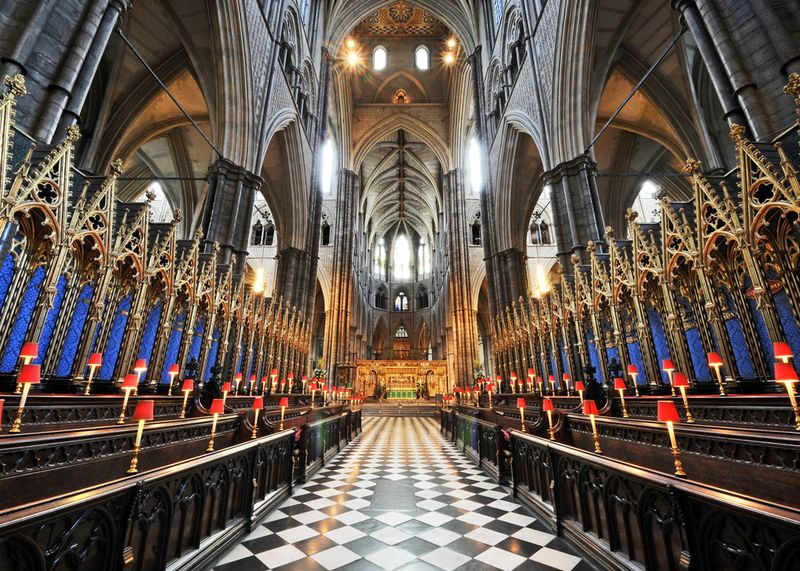
Where English royalty has been crowned since 1066, Westminster Abbey serves as both royal stage and national pantheon. The Gothic church houses the tombs and memorials of Britain’s greatest figures, from monarchs to scientists, poets to politicians.
Poets’ Corner contains memorials to literary giants like Shakespeare, Dickens, and Austen. The elaborate Henry VII Chapel showcases the finest example of fan vaulting in existence, its stone ceiling resembling delicate lace.
Many miss the medieval Pyx Chamber and Chapter House with its original medieval floor tiles. To avoid crowds, consider attending Evensong service, which allows you to experience the Abbey’s magnificent acoustics filled with choral music without paying an entrance fee.
10. Chartres Cathedral – Chartres, France
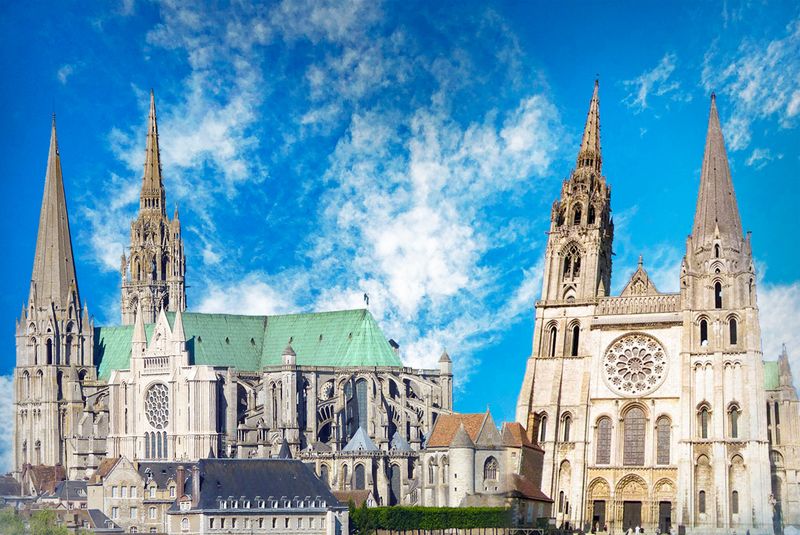
Famous for having the finest collection of medieval stained glass in existence, Chartres Cathedral glows with jewel-toned light. The 176 windows create an otherworldly blue atmosphere known as “Chartres blue” that has inspired artists for centuries.
The cathedral contains the Sancta Camisa, believed to be the tunic worn by Mary during Christ’s birth. This relic made Chartres one of medieval Europe’s most important pilgrimage sites.
Don’t miss the ancient labyrinth inlaid in the floor, which pilgrims would traverse on their knees as a form of penance. The contrasting spires – one plain Romanesque, one flamboyant Gothic – resulted from rebuilding after a fire, creating the cathedral’s distinctive asymmetrical silhouette.
11. Canterbury Cathedral – Canterbury, England
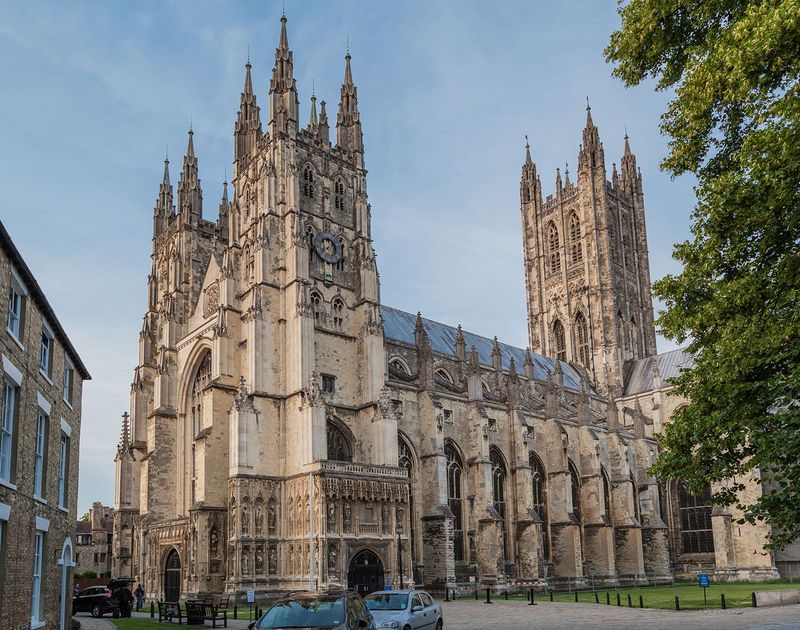
Scene of Archbishop Thomas Becket’s infamous murder in 1170, Canterbury Cathedral became one of medieval Europe’s most important pilgrimage destinations. The soaring Gothic nave and choir showcase the evolution of English architecture over several centuries.
Miracles were said to occur at Becket’s shrine, which Henry VIII destroyed during the Reformation. The exact spot is marked by a single candle in the Trinity Chapel.
The cathedral’s stained glass includes some of the oldest surviving examples in Europe, dating to the 12th century. The intricate fan vaulting of Bell Harry Tower represents the pinnacle of late medieval craftsmanship. Evensong services allow visitors to experience the cathedral as generations of pilgrims have – filled with ethereal music.
12. Seville Cathedral – Seville, Spain
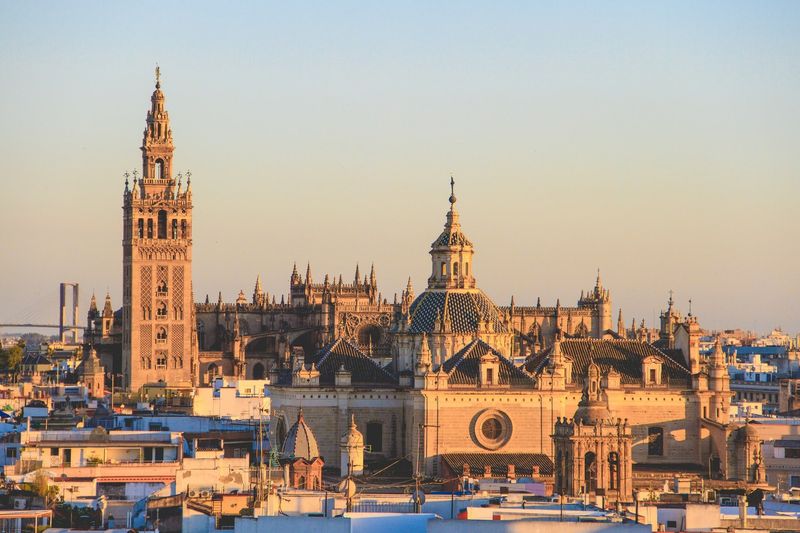
Officially the world’s largest Gothic cathedral, Seville’s massive church was built to demonstrate the city’s wealth and power. Legend claims the planners declared, “Let us build a church so beautiful and so grand that those who see it finished will think we were mad.”
Christopher Columbus’s tomb sits inside, carried by four royal pallbearers representing the kingdoms of Spain. The Giralda tower, originally a minaret, provides stunning views for those willing to climb its 35 ramps (built wide enough for horses).
The cathedral contains an astonishing 80 chapels and the largest altarpiece in the world. During Holy Week, elaborate processions of life-sized religious figures pass through the massive doors, continuing traditions dating back centuries.
13. Washington National Cathedral – Washington, D.C., USA
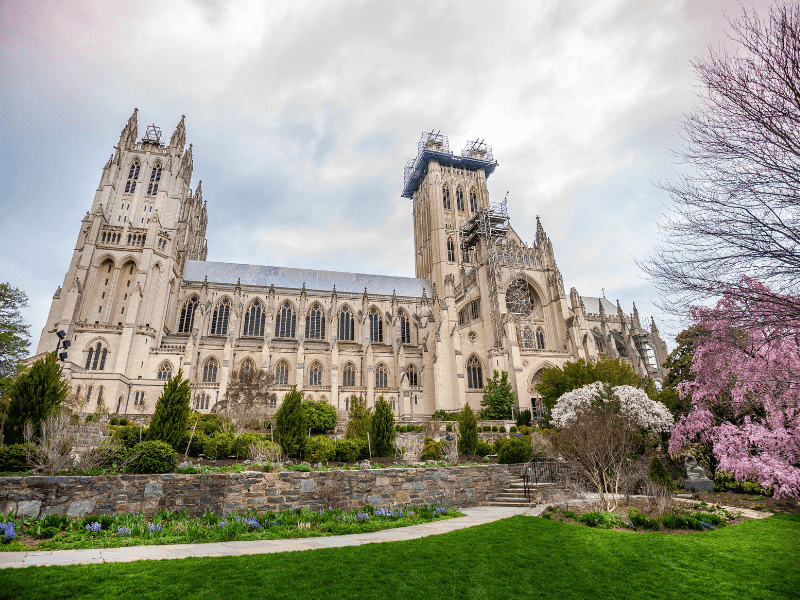
America’s Gothic masterpiece took 83 years to complete, finally finished in 1990. This newcomer among historic cathedrals contains fascinating modern touches, including a stained glass window with a piece of lunar rock from Apollo 11.
Whimsical gargoyles include Darth Vader peering down from a high tower. The cathedral has hosted presidential funerals and national prayer services, serving as America’s spiritual home during times of celebration and crisis.
The cathedral’s central tower stands as the highest point in Washington D.C. Explore the beautiful Bishop’s Garden with plants mentioned in the Bible and medieval literature. The cathedral’s Episcopal roots don’t prevent it from serving as an interfaith gathering place for the nation.
14. St. Stephen’s Cathedral – Vienna, Austria
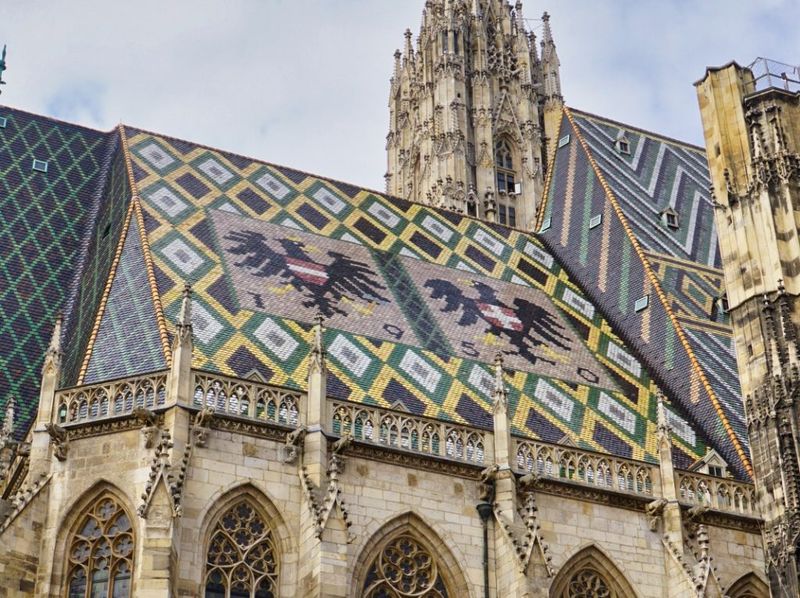
Stephansdom’s distinctive zigzag-patterned roof and soaring south tower have defined Vienna’s skyline for centuries. The colorful roof tiles form a mosaic of the Habsburg double-headed eagle.
Below the cathedral lies a labyrinth of catacombs containing the remains of over 11,000 people. During the plague years, the catacombs were filled so quickly that some corpses were simply packed with quicklime rather than properly buried.
The cathedral survived severe damage during World War II when retreating SS troops set fire to nearby buildings. Viennese citizens formed bucket brigades to save their beloved landmark. Don’t miss the view from the north tower, or the massive Pummerin bell, cast from cannons captured from invading Turkish armies.
15. Reims Cathedral – Reims, France
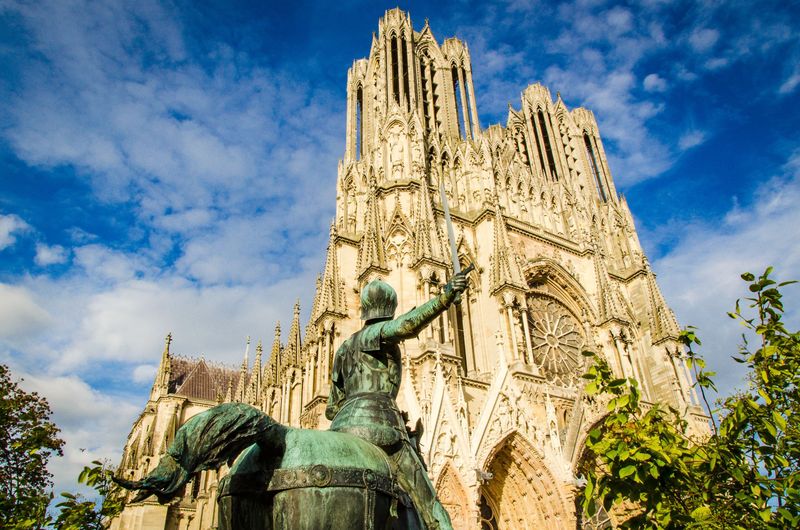
Coronation site of French kings for over a thousand years, Reims Cathedral embodies the height of High Gothic architecture. The western facade features one of the most beautiful collections of sculptures from the 13th century, including the famous Smiling Angel.
Heavily damaged during World War I, the cathedral became a symbol of French suffering and resilience. American philanthropist John D. Rockefeller Jr. funded much of the restoration.
The cathedral’s stained glass includes both medieval masterpieces and modern windows by Marc Chagall. During summer evenings, a sound and light show projects colorful images onto the facade, recreating how the cathedral would have appeared when originally painted. The surrounding Champagne region adds another reason to visit this historic treasure.
16. Santiago de Compostela Cathedral – Santiago de Compostela, Spain
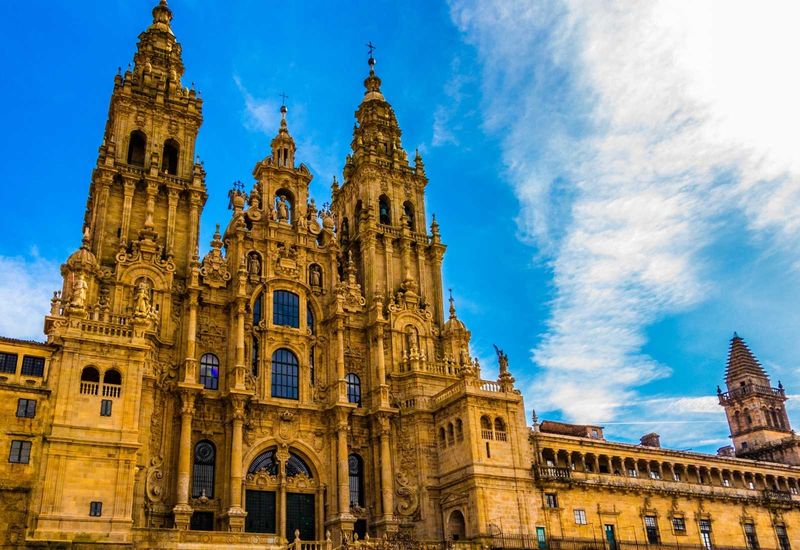
Final destination of the ancient Camino de Santiago pilgrimage, this cathedral welcomes thousands of weary travelers who have walked hundreds of miles to reach it. The western Portico de la Gloria contains some of the finest Romanesque sculpture in existence.
The highlight for many visitors is the swinging of the Botafumeiro, a massive silver incense burner that flies through the transept on special occasions. Originally used to mask the smell of unwashed medieval pilgrims, it now creates an unforgettable spectacle.
Tradition calls for pilgrims to embrace the statue of St. James behind the altar and touch their foreheads to a column in the Portico. The cathedral museum houses a remarkable collection of tapestries and religious artifacts gathered over a thousand years of pilgrimage.
17. Mont Saint-Michel Abbey – Normandy, France
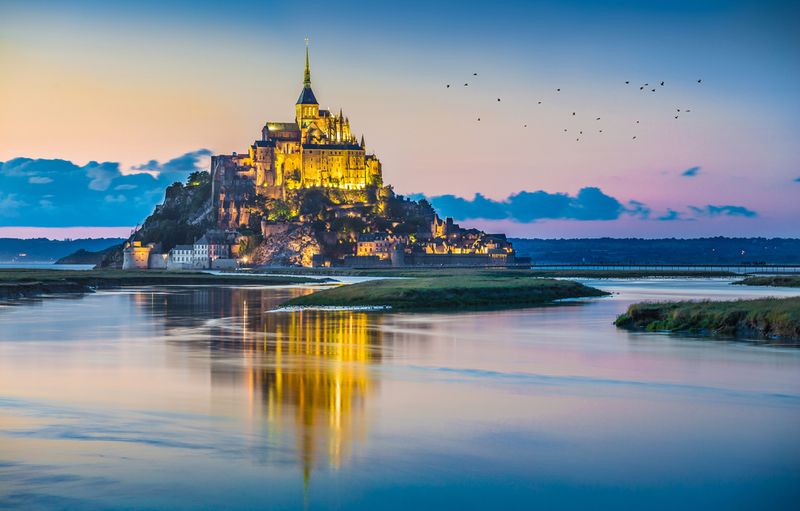
Rising dramatically from a rocky tidal island, Mont Saint-Michel seems more fantasy than reality. The abbey church crowns this medieval village, creating one of the most recognizable silhouettes in Europe.
Massive stone pillars in the crypts support the structure known as “La Merveille” (The Marvel). Monks built this architectural wonder despite seemingly impossible logistics, hauling materials up steep paths.
Time your visit carefully – the surrounding bay experiences some of Europe’s most dramatic tides, with water rushing in “as fast as a galloping horse.” The island becomes completely surrounded by water during high tide, recreating the isolation monks sought. Stay overnight to experience the magic of the mount after day-trippers depart.
18. La Sagrada Familia – Barcelona, Spain
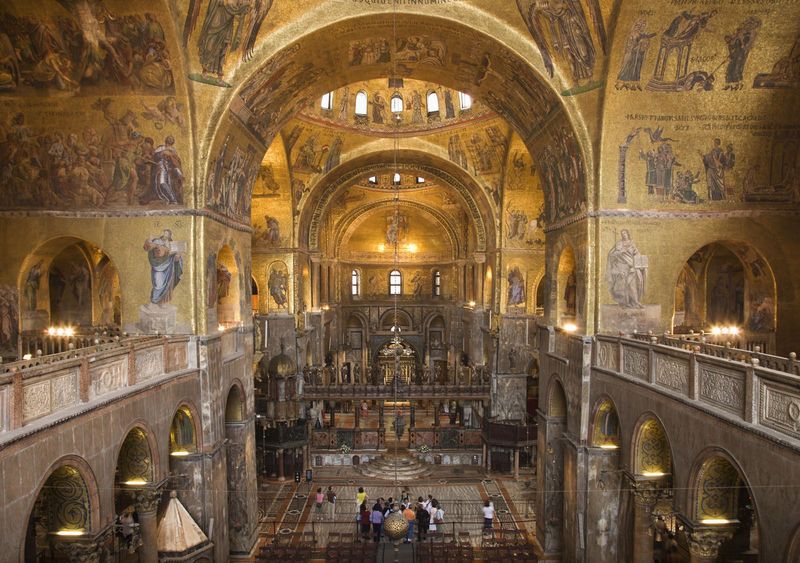
St. Mark’s Basilica shimmers with golden Byzantine mosaics covering over 8,000 square meters of the interior. Unlike the soaring Gothic cathedrals of northern Europe, this church creates a sense of mystery through its lower domes and atmospheric lighting.
The four bronze horses above the entrance were looted from Constantinople during the Fourth Crusade. Napoleon later took them to Paris, but they were eventually returned to Venice.
The basilica’s exterior shows the influence of Islamic architecture, reflecting Venice’s position as a trading crossroads. Visit late afternoon when the light brings the golden mosaics to life. Consider booking the “Secret Itineraries” tour to access areas normally closed to the public.
19. St. Patrick’s Cathedral – New York City, USA
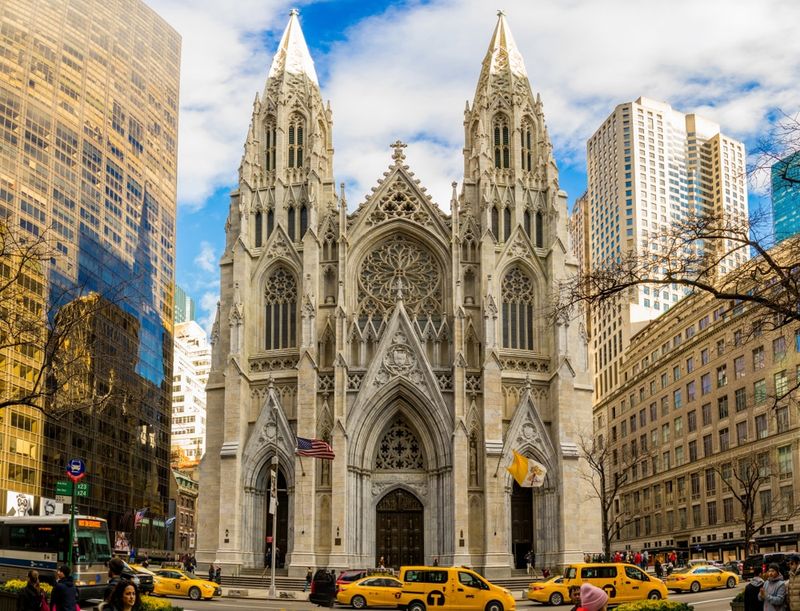
Rising amid Manhattan’s skyscrapers, St. Patrick’s neo-Gothic spires offer a spiritual counterpoint to the commercial energy of Fifth Avenue. Completed in 1878, the cathedral seemed absurdly large and far from the city center, but New York quickly grew around it.
The cathedral underwent a massive $177 million restoration completed in 2015, cleaning decades of grime from the white marble facade. The 10,000-pipe organ fills the vast space with music during regular recitals.
Famous figures including Babe Ruth, F. Scott Fitzgerald, and various Kennedys had funeral services here. During Christmas season, the cathedral becomes especially magical with its nativity scene and musical performances. Even in bustling Midtown, the interior provides a peaceful sanctuary.
20. Duomo di Firenze – Florence, Italy
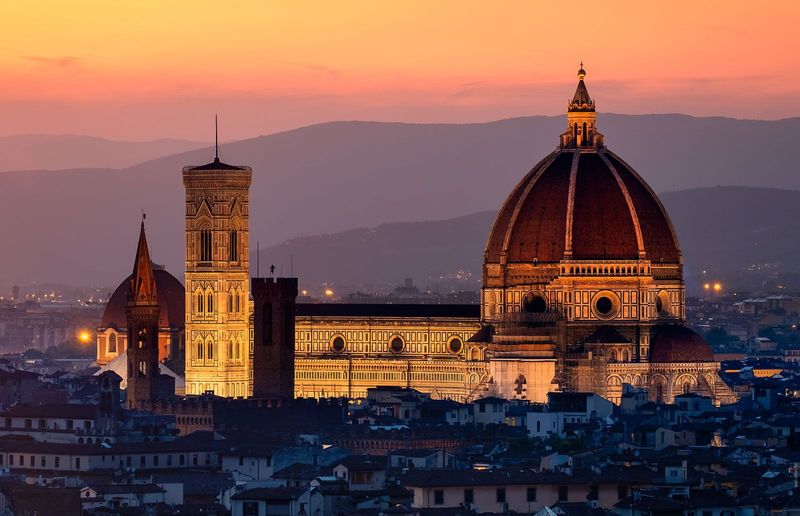
Brunelleschi’s revolutionary dome transformed architecture forever and remains Florence’s defining landmark. The red-tiled cupola was an engineering marvel, built without scaffolding using techniques that remain somewhat mysterious today.
Climbing the 463 steps between the dome’s inner and outer shells reveals how this Renaissance masterpiece was constructed. Visitors walk alongside Vasari’s Last Judgment frescoes covering the interior dome surface.
The cathedral’s multicolored marble facade wasn’t completed until the 19th century, nearly 600 years after construction began. Giotto’s separate bell tower offers equally spectacular views for those who climb its 414 steps. The octagonal Baptistery across the piazza contains Ghiberti’s bronze doors, which Michelangelo called the “Gates of Paradise.”
